Places Visited: Wyoming: Casper, Buffalo, Ten Sleep, Powder River Pass
in Big Horn Mountains.
July 16, 2006: Casper East RV-Park Casper, Wyoming.
Casper East RV-Park is a mom and pop operation without a mom & pop! N42°
51.357' W106° 17.338' $28 for full hookup $4 cheaper for water & 30-amps
central sewage. They feature gravel interior roads & pads: This is NOT a destination
campground by any means however, it certainly looks much better than the Fort
Casper RV-Park which is nothing but a crowded dusty dirt parking lot.
Joyce
had a day in the "Big Horne Mountains" planned for us today. Whenever
we were in this area in the past we were always passing through in the motorhome.
Taking our motorhome over the Big Horn Mountains is NOT an option for us so we
always skirt around them. Today we headed to Buffalo for the express purpose of
taking the Saturn over the Big Horns from Buffalo to Ten Sleep. The 5,000 foot
change in altitude is a hard pull for even the Saturn. We can't believe that some
people pull motorhomes and 5th wheels over that pass. I suspect that most who
do it the first time will not do it again. Along the way we saw a number of motorhomes
in distress and could only wonder what they were thinking now.
For those
of you who are not familiar with the Big Horn Mountains let me set the stage.
The Big Horns are some serious mountains that trend north and south in north central
Wyoming. I-25 that runs north south through Wyoming skirts the eastern foothills
of the Big Horns. If you are familiar with I-90 you will know that when westbound
I-90 gets to Buffalo it turns north toward Sheradin, Wyoming and continues northward
to Billings, Montana skirting around the northern end of the Big Horns before
continuing west. Only two decent roads traverse these mountains US-14 from Sheridan
to Greybull and US-16 from Buffalo to Ten Sleep. Be prepared for serious mountain
grades when crossing either of these. US-14 starts in Sheradin at 3,745' and ends
in Greybull with Granite Pass at 9,033 in between. US-16 over the Big Horns for
us started in Buffalo situated in the eastern foothills at an elevation of 4,645'
then went to Powder River Pass at 9,666' before dropping into Ten Sleep at 4,206'
in the western foothills, all in 62-miles. For those of you from the east who
are not accustomed to mountain driving that is a serious grade any way you dice
it. While the grade is serious engineers were able to negotiate those grades without
the customary series of switchbacks. US-16, as I recall, was relatively free of
switchbacks. I do not recall any switchbacks that required us to reduce speed
to 15-mph or anything close to that.

Joyce
took this picture of the Big Horn mountains as we drove to Buffalo on I-25 with
the Big Horn Mountains on our western flank. The mountains are 5 to 10 miles to
the west.

This
picture of the Big Horns was taken from US-16 as we were in the foothills heading
into the heart of the mountains. In case you are wondering that is snow on the
peaks.
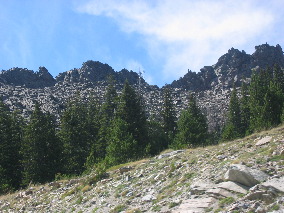

At
the top of Powder River Pass elevation 9,666', igneous rock on the peak was visible.
This
group of "hot shot" fire fighters from Craig, Colorado were waiting
for assignment in the parking area on Powder River Pass.
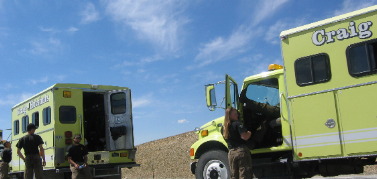
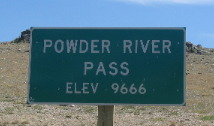
Yes
that is a female "hot shot" fire fighter. That is not uncommon with
these fire fighting units.
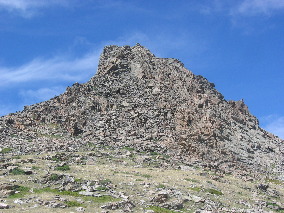
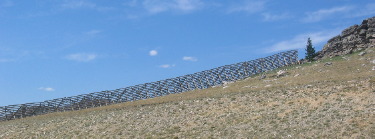
That
is the craggy peak of Powder River Pass.
Massive snow fences are set to
protect the pass from wind blown snow.
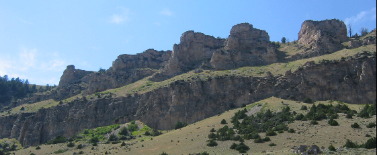
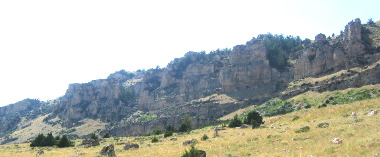
As
we near the Ten Sleep we enter about 10-miles of spectacular canyon cut by the
Powder River.

Millions
of years of geology are exposed in this canyon.

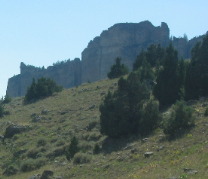
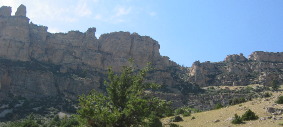
Spectacular
is the only way to describe Ten Sleep Canyon.
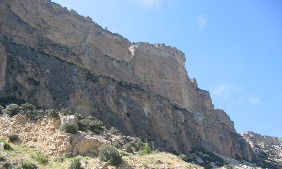
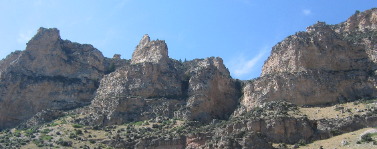
On
both sides the geology memorizes us.
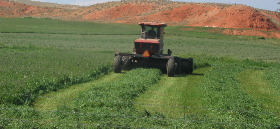
Once
we get to Ten Sleep we turned south on State Road 434 following the Nowood River
and the western foothills of the Big Horn Mountains. Ranches dotted this road.
In the river valley farmers were irrigating vast fields of alfalfa. This farmer
was mowing a large field of alfalfa on land at least 1/2 mile away from the river
but flat enough to farm.

Ten
miles or so down SR-434 we ran across a historical information kiosk that told
about one of the skirmishes in the sheep & cattle wars in this area experienced
in the early 1900's. The kiosk was was covering the Spring Creek Raid that occurred
on April 2, 1909. Cattlemen of the Big Horn Basin dominated the range where sheep
were forbidden. Fierce animosity grew between the opposing sheep and cattle ranchers
as several sheep camps were raided during the late 1800's and early 1900's.
In
late March, 1909, Joe Allemand, a French sheepman, ad Joe Emge, a cattleman turned
sheepman, left Worland headed for Spring Creek with 5,000 head of sheep. They
were accompanied by Allemands's nephew, and two sheepherders. Talk spread like
wildfire across the western slope of the Big Horn Mountains as the deadline was
crossed and plans were soon made to head off this intrusion.
On the moonlit
night of April 2, 1909, seven masked riders approached the sheep camp's two wagons
where the herders slept. Gunfire lit the night as rifles blazed. The sheep men
were killed in their wagons and the wagons set on fire. A monument is located
where the murder of these sheepmen took place.
Five of the perpetrators
were convicted and sent to prison. Public reaction against this brutal and tragic
act left no doubt that violence on Wyoming's open range would no longer be tolerated.
At least that is what the kiosk said.
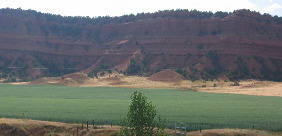
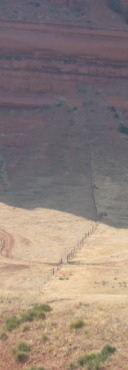
With
the history lesson behind us we continued south on that road. It turned to a dirt/gravel
road less than 10-miles south of Ten Sleep. The scenery was just too spectacular
to stop so on we went. Alfalfa fields and red cliffs make an interesting spectacle
on one side of the road while the river and Big Horn Mountains dominate the eastern
side.
I was fascinated by this fence that climbed up the side of
that redstone cliff until it reached the sheer vertical rock wall.
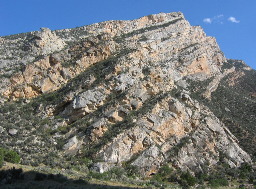
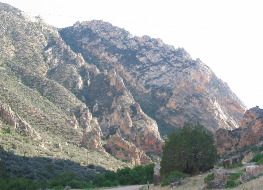
Forty
five miles south of Ten Sleep we navigated through a series of canyons that the
Nowood River carved through the western flank of the Big Horn Mountains. It is
obvious that the river has selected a series of spectacular faults to in which
to traverse its way through the mountains. As the earth uplifed the river cut
through the hard rock exposing millions of years of geology. The severe angles
on these strata provide an indication of the forces involved in shaping this country.
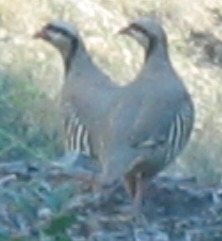
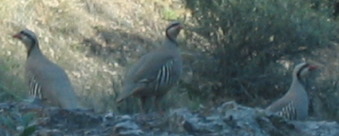
In
one of the canyons Joyce spotted these chukar. We had never seen chukar in the
wild. In fact the only chukar we had ever seen was at a wild game auction in Harper,
Texas.

Sometimes
we are proned to think that our hamburgers are raised in pens and forget that
ranchers in this part of the country are still driving cattle over miles and miles
dirt trails. Here is a sign marking one of those trails leading into the Big Horn
Mountains to what I suppose is summer pasture.
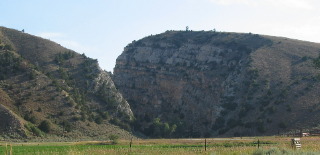
This
canyon was 50 or so miles south of Ten Sleep and 40-miles or more down that dirt
road.
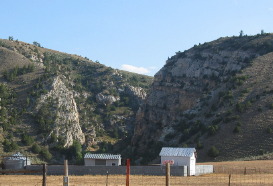
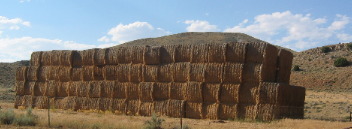
This
is the same canyon from a head on angle where a remote ranch is situated at the
mouth of the canyon. Near that ranch was this huge stockpile of hay that had been
hauled in since there were no alfalfa fields within 10-miles of this ranch house.

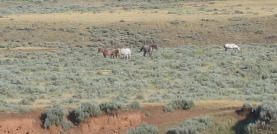
By
this time we are in really remote country. Occasionally, we spot small herds of
wild horses in the sage.

Then
we spotted several cows roaming the countryside. We are in "open range"
where there are no fences so we are constantly on the lookout for cows in the
road.
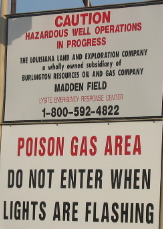
Then
we started seeing these signs and evidence of gas wells mixed in the sage grass.

When
this gas refinery came into view we knew civilization was near. We were mostly
right. The dirt road continued for another 5 to 10-miles.
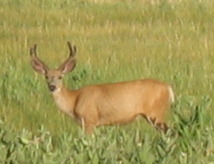
We
spotted this buck in tall grass located near a small river.
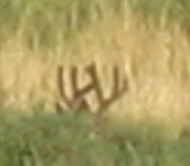
This
buck was mostly hidden in the tall grass. The only thing that gave him away was
his huge rack.
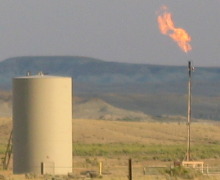
This
flame was burning off poisonous gas.
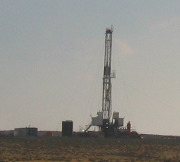
Just
before reaching paved road we saw this drilling rig sinking another gas well.
Later we learned that these gas wells were over 30,000 feet deep and took 5-years
of drilling to reach that depth.
We were on this adventure
for over 12-hours. We could not have seen more spectacular country anywhere. Tomorrow
will be a down day, we have to recoup.
Until next them remember how
good life is.
Mike & Joyce Hendrix